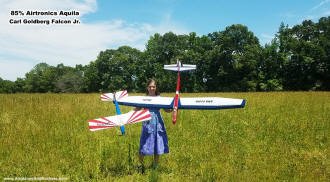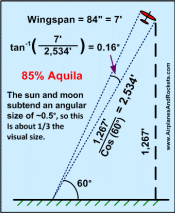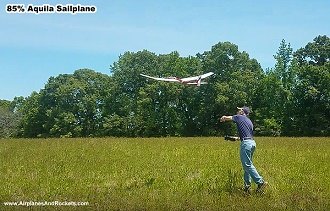|
 You might have noticed that I have a "thing"
for the Aquila
glider. Having built two - one from plans and one from a kit - back in the mid-1970s
when the article first appeared in RC Modeler magazine, I developed an appreciation
for the graceful lines and the flight performance. In later years I modified a Great
Planes 2-Meter Spirit glider to look a bit like the Aquila, and dubbed it the
Aquila Spirit. Next, never having
had a glider with a wingspan greater than 99", I scaled up the Aquila plans to 105%
and built that - my 105% Aquila.
That one, which was a lot of work to build, was sold to a guy in Maryland before
making a household move. You might have noticed that I have a "thing"
for the Aquila
glider. Having built two - one from plans and one from a kit - back in the mid-1970s
when the article first appeared in RC Modeler magazine, I developed an appreciation
for the graceful lines and the flight performance. In later years I modified a Great
Planes 2-Meter Spirit glider to look a bit like the Aquila, and dubbed it the
Aquila Spirit. Next, never having
had a glider with a wingspan greater than 99", I scaled up the Aquila plans to 105%
and built that - my 105% Aquila.
That one, which was a lot of work to build, was sold to a guy in Maryland before
making a household move.

See my Winged Shadow Systems' How High™ electronic altimeter
teardown report.

News Flash: I set a personal
thermalling altitude record of 1,267 feet in
my 85% Aquila glider on May 23, 2024! The drawing shows the best case visual
size with full wingspan facing pilot is about 1/3 the of the sun and moon.
Now, desiring another Aquila, I decided to build a version with a one-piece wing,
but did not want it to be 99" long. Two meters was too short, so I went with an
85" wingspan. That is the one pictured and described here. Because large flying
sites are so hard to come by, I elected to install a motor in the nose, but also
provided for a tow hook just in case. As noted in the 105% Aquila write-up,
because of the tail-heaviness of the unballasted model, replacing the NiCad battery
and lead weight in the nose with a brushless motor and propeller, 850 mAh LiPo
battery, and ESC only added 2-3 ounces.
Note the unique method for attaching the wing. I didn't want a removable cut-out
section in the fuselage, so instead the wing passes through the fuselage and is
held fast with a couple small rubber bands. The rubber bands only keep the wing
in alignment. I've never seen anything like it before, so maybe I've just invented
a new method of wing attachment (patent pending).
Also, rather than building an all-flying stabilizer (stabilator), I opted for
a conventional horizontal stabilizer and hinged elevator. It sacrifices the removability
for easier transportation and storage, but I'll live with it. The rudder hinge pins
are fixed, unlike the original that allowed removal of the rudder as well. It saves
weight and complexity. The full-size Aquila and 105% Aquila needed lead ballast
in the nose to compensate to the heavier empennage, but this 85% Aquila balances
with no ballast. A final all-up flying weight has not yet been determined. Spoilers
were omitted, too. They are very effective on the other Aquilas, but I never really
felt like it was something I couldn't live without.
As of this writing, all the construction is complete and the covering is nearly
done. I still need to finish installing the electronics and attach the canopy to
the frame (always a daunting task). Hopefully, the 85% Aquila's maiden flight
will happen within the next two weeks.
Update: See Maiden Flight Photos Below. Final flying weight
is 24.8 oz, which with its 580 in2 wing area, works out to be about
6.2 oz/ft2.
|

85% Aquila Sailplane Glider Maiden Flight Launch











|

Radio Installation of 85% Aquila Sailplane



Measuring and aligning wing for center and skew








|
Posted April 15, 2023
|



